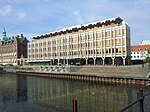The Battle of the Sound was a naval engagement which took place on 8 November 1658 (29 October O.S.) during the Second Northern War, near the Sound or Øresund, just north of the Danish capital, Copenhagen. Sweden had invaded Denmark and an army under Charles X of Sweden had Copenhagen itself under siege. The Dutch fleet was sent to prevent Sweden from gaining control of both sides of the Sound and thereby controlling access to the Baltic Sea as well as of its trade.
The Dutch, under the command of Lieutenant-Admiral Jacob van Wassenaer Obdam with Egbert Bartholomeusz Kortenaer as his flag captain, who had sailed to the Baltic in support of Denmark, had 41 ships with 1,413 guns while the Swedes, under Lord High Admiral Carl Gustaf Wrangel, had 45 ships with 1,838 guns. The Dutch were grouped into three squadrons, while the Swedes separated their ships into four. The seven Danish ships with about 280 guns were unable to assist their Dutch allies because of adverse northern winds and could only watch. Obdam, who initially received written instructions from the Grand Pensionary, Johan de Witt that were very complicated and confusing to Obdam. He requested the orders to be given to him again "in three words", with de Witt replying with a single sentence: "Save Copenhagen and punch in the face anyone who tries to prevent it". The "anyone" was a reference to the English, whose powerful fleet had recently defeated the Dutch in the First Anglo-Dutch War, leading to the Dutch suspecting an English fleet present might come to the aid of the Swedish, although the English simply observed the fighting from a distance, being allied to neither side. The Swedes attacked aggressively, but failed to gain the upper hand, primarily because the approaching Dutch had the weather gage. The Dutch forced the Swedish fleet to end the blockade of the Danish capital, enabling its resupply by Dutch armed transport ships, which eventually forced Charles to abandon the siege entirely.
The Swedes lost five ships in the action compared to one Dutch ship, however, the remaining allied ships were more damaged. Also, considering the slightly fewer losses of men in the Swedish navy, 1,200 compared to 1,400 (439 killed, 269 captured and slightly more than 650 wounded allies), the battle is considered a tactical draw. Strategically, however, it was a major allied victory.










